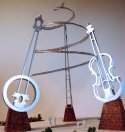
Proposal
Following is the original proposal for the Eastern Kentucky Heritage Monument. We are proposing a World Class venue. Nothing less will suffice. The support for this project has been overwhelmingly positive.
This proposal was presented in 2002. Changes from the original due to subsequent experience are noted in [brackets].
Eastern Kentucky
Heritage Monument
-A Proposal-
To celebrate, honor and affirm the cultural, economic and historical contributions of the people of Eastern Kentucky we hereby propose the "Eastern Kentucky Heritage Monument."
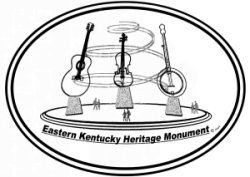
David Musser, Project Director Eastern Kentucky Heritage Monument PO Box 1003 Campton, KY 41301 (c) 2002
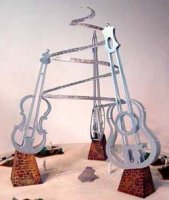
A Brief Description
The Eastern Kentucky Heritage
Monument consists of three large, steel, stylized traditional
instruments- a guitar, banjo and fiddle- resting on a round,
stepped, concrete platform covered by a façade of recycled Civilian
Conservation Corps sandstone. The instruments are arranged in a
triangular pattern.
The framework of each instrument,
which defines the shape, is made of steel. The framework is the
sculpture. There are no solid tops or backs.
The instruments, in addition to their
attributes as sculpture, are giant wind harps. A visitor standing
between the instruments will hear the harmonic vibrations caused by
the wind blowing across the strings.
Inscribed on the platform floor are
the autographs and hometowns of Eastern Kentucky musicians, authors
and artists. The goal is to honor a diverse cross-section of
deserving Eastern Kentucky artists ranging from the famous to the
back porch variety.
The monument sits on top of a hill.
The combination of visual and auditory stimuli will be quite
stunning, truly astonishing and absolutely unforgettable.
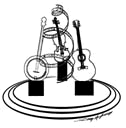
The Eastern Kentucky Heritage Monument
Experience
The visiting family, traveling down the Mountain Parkway, climbs
Slade Hill onto the Pottsville Escarpment. There is no doubt they have
left the flatland behind and entered an extraordinary place, the Appalachian Mountains. Soon,
they see in the distance, proudly perched atop a hill, the whimsical
outline of giant musical instruments. The view brings a smile. And
that initial smile sets the tone for the entire Eastern Kentucky
adventure.
The family exits the Parkway and
drives to the Eastern Kentucky Heritage Monument parking lot. The
Monument, above and beyond the Welcome Center, looms large and
beckons them onward. They enter the Welcome Center, take a quick
look around as they search for the restrooms, and then gather at the
foot of the stairs to start the ascent to the mountaintop.
The stairs are wide. The step rise is
gentle, the tread is deep. It is an easy, but not short climb. The
children surge ahead, the parents call them back. When they reach
the viewing platform they are slightly winded. Their first view at
the top is accompanied by deep oxygen seeking breaths. By their
effort, they have paid the pilgrims’ toll.
The instruments powerfully draw their
attention upward. The impossibly large instruments are not only
framed by the sky but actually filled with the sky. The family feels
the exhilaration of standing on a mountaintop. The sensation is
marvelous and overwhelming. The family stands in wonder as their
gaze drifts among the giant sculptures.
They are unconsciously drawn to the
center of the viewing platform to get a more balanced perspective.
They do not notice walking across the names inscribed on the floor
nor do they observe the large map of Kentucky under their feet.
Slowly, they become conscious of the
quiet, delightful sound of shifting harmonic overtones produced by
the wind blowing across the strings of the instruments. It gradually
occurs to them that the sound is coming from the instruments, played
by an unseen hand.
A scientist might point out that the
neurons in the spatial, visual and imaginative centers of the brain
have been firing at a prodigious rate. The auditory centers are now
demanding attention. The scientist would call this a "right-brain"
event.
Eventually, our visitors begin a
general survey of their surroundings. They enjoy the panoramic
mountaintop view and feel the wind in their faces. They begin to
notice their fellow visitors and the shared sense of elation.
In due time they look down- partially
to relieve the neck muscles but mainly to restore mental
equilibrium. They discover that they are standing on a large map of
Kentucky. They note the rivers, the cities, the towns, various
points of interest and the colors depicting elevation and
vegetation.
Our scientist friend would point out
that the neurons in the logical, analytical, objective centers of
the brain are becoming active. The scientist would call this a
"left-brain" event. And the left-brain, in order to reclaim
dominance after the shameless indulgence by the right-brain, is
going to be very much engaged. In the next few minutes, our visitors
will learn a great deal about the topography of Kentucky.
Our visitors next notice that what
they thought was an abstract design on the floor is actually
signatures- signatures accompanied by the name of a town. Some of
the names they recognize. Most they do not. A passerby comments that
the signatures are color-coded. The ones in black are authors, the
ones in blue are musicians, the ones in red… But they are all
Kentuckians.
In time, our visitors tire and sit on
a bench. Here they reflect on the experience and allow their minds
to rest. They enjoy the moment; the art, the view, the sounds, the
place. They relax.
In due course, it is time to go.
Rather than return by the stairs, they choose to take the gently
sloping path. The path is attractively and thoughtfully landscaped.
Native plants and trees are marked for identification. Partway down,
they intersect the walking trail that circumnavigates the Monument.
As they near the bottom and approach the stairs they first ascended,
the family notices the path leading to the amphitheater. But the
desire for a snack lures them back to the Welcome and Information
Center.
After a light lunch they tour the
Welcome Center. The circular floor plan encourages them to make the
full circuit. They pass the artists’ displays and appreciate the
high quality. They might purchase an item. At the music section a
couple of people are playing old time mountain music. The family
lingers at the educational displays. Next, they stop awhile at the
first electronic interactive map. The names of all the people they
saw on the monument floor are here. They press one. "James Still." A
light flashes on the map at Troublesome Creek in Knott County. A
recording begins, "Though the sun-ball breaks the ridges into dust.
Being of these hills, being one with the fox,
I cannot pass beyond …"
Returning to the main foyer, our
visitors are ready for information concerning the places of interest
for their Eastern Kentucky adventure. There is the normal rack of
brochures to which they will later return. But first they go to the
large map and see what Eastern Kentucky has to offer. Close by are
several four-sided kiosks. Each side has an interactive map of the
region. Our visitors press "Cumberland Falls" and the route from the
Monument to Cumberland Falls is lit on the map. (Or the route from
"Pine Mountain" to "Cumberland Falls" depending on how the vacation
is planned.) Simultaneously, a short video of Cumberland Falls
appears on the monitor. "Wow," exclaim our visitors, "we have to go
there!" And so on.
A visit to the Gift Shop is next. And
then, perhaps, one more excursion back to the Monument. The
ever-changing sky makes every trip unique.
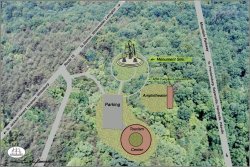
The Importance of Image
When a person thinks of a particular
geographic location the thought is usually associated with a
specific image. Mention Paris and the Eiffel Tower comes to mind.
China- the Great Wall. Allude to Hawaii or Florida and immediately
and involuntarily a mental picture of beaches and palm trees is
conjured.
In the case of Paris and the Eiffel
Tower the image is specific. In the case of Hawaii or Florida the
image is general. Both cases fall into the category of Public Myth,
the eternal spring of the Advertising and Tourism Industry. Eastern
Kentucky needs a specific image, a focal point, that represents the
entire region.
If the words "Eastern Kentucky" are
mentioned to a person from outside the area, what image is evoked?
At best, a vague picture of a backward, slightly mysterious region.
At worst- feuds, moonshine, poverty and environmental degradation.
If Eastern Kentucky is to prosper, it
is imperative that we redefine our image in the Public Myth.
Redefining the Image of Eastern Kentucky
The Eastern Kentucky Heritage
Monument reinvents the image of Eastern Kentucky into one of our own
choosing. No longer will we labor under the negative and incorrect
stereotypes forced upon us by the powerful public media from outside
the area. Our Monument will celebrate our strengths, our
contributions and what is good about Eastern Kentucky.
The Eastern Kentucky Heritage
Monument must, absolutely and unequivocally, adhere to the highest
artistic and architectural values.
Our monument represents and uplifts
the image of all of Eastern Kentucky. It is a powerful, affirmative,
confident symbol.
The Eastern Kentucky Heritage
Monument will be our international logo.

Tourism
The impact of The Eastern Kentucky
Heritage Monument on tourism is truly enormous. It represents an
ongoing value far beyond the monument’s cost. While Eastern Kentucky
has many wonderful places worth visiting, there is no single point
of reference that defines Eastern Kentucky in the mind of an
out-of-state visitor. Our Monument, along with the publicity it
would generate, would provide the focal point that firmly
establishes Eastern Kentucky as a particular place and uniquely
mysterious region worth visiting. This Monument would create a
specific image- friendly, slightly whimsical, and unabashedly proud-
that would benefit tourism in all of Eastern Kentucky.
The Eastern Kentucky Heritage
Monument is the representative image of all Eastern Kentucky. It is
not a solitary destination but rather the starting point for the
Eastern Kentucky adventure. It is the staging area for further
exploration of the region. All of Eastern Kentucky will benefit.
A primary objective of the Monument,
and particularly of the Welcome, Information and Interpretive
Center, is to promote tourism throughout all of Eastern Kentucky.
After touring the Monument and Information Center, the visitor is
better informed about the opportunities available in Eastern
Kentucky. But more importantly, the visitor is more comfortable
about Eastern Kentucky in general. Informed and comfortable visitors
translate into an economic windfall for the entire region.
Cultural Contributions Worthy of Celebration
In proportion to its size, Eastern
Kentucky has produced an inordinate number of musicians, artists and
writers. Many of these people have national name recognition. But
the true significance of this phenomenon is the cultural milieu that
allowed these artists to develop. The isolation of the Eastern
Kentucky mountains produced a people with a unique cultural
perspective appreciated by a worldwide audience. Our artists
continue to contribute to the national and international arts
community.
The coalfields of Eastern Kentucky in
the early part of the twentieth century had arguably the most
ethnically diverse constituency of any region in America. One mine
reported workers from thirty-eight nations. English, Welsh, Polish,
German, Scotch, Irish and Italians along with ex-slaves from the
south contributed their distinctive point of view to the growing
culture of Appalachia. This led to an equality seldom, if ever,
duplicated in this country. One prominent writer has called current
Eastern Kentucky "the most classless society in America."
Eastern Kentucky’s role in history
should also be honored. Daniel Boone, westward expansion, the
Wilderness Trail, Cumberland Gap, the coal industry and military
volunteerism are some of the historical landmarks worthy of
distinction.
There are many reasons Eastern
Kentucky should be honored with a monument.
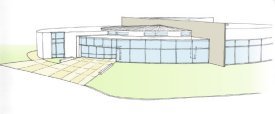
Welcome, Information and Interpretive Center
[The Celebration Center]
The Welcome, Information and
Interpretive Center will also adhere to the highest quality
standards. It is not a "tourist trap." It will in no way perpetuate
old, negative stereotypes.
The primary function of the Welcome,
Information and Interpretive Center is to provide the visitors with
the information to better plan and organize their stay in Eastern
Kentucky. "User Friendly" interactive computer kiosks will help the
visitors familiarize themselves with all of what Eastern Kentucky
has to offer. They will be able to prepare their trip more
thoughtfully, see and visit more areas, and thereby extend their
stay.
The Welcome, Information and
Interpretive Center will help the visitor understand, organize and
integrate the various tourism projects initiated by State and
Federal programs.
The Gift Shop contains only items
made in Kentucky. The items are juried and of high quality. Nothing
"tacky." The Gift Shop plays a secondary role at the Center. It is
not the dominant feature.
There are areas for visual artists,
photographers, textile artists, potters, and craftspeople to display
and sell their work. There will also be areas to showcase Kentucky
authors and musicians.
The rest rooms are large.
The footprint of the Welcome,
Information and Interpretive Center is round (or oval) with an open
space in the middle. This space is used for open-air dining from the
snack bar as well as for resting and relaxing. The round shape
invites the visitor to take a circular tour of the Center.
The Welcome, Information and
Interpretive Center, as well as the parking lot, is located below
and away from the Monument. It is separate from the Monument
in both physical distance and emotional content.
[We now call this feature the Information and Celebration Center to more accurately describe its function.]
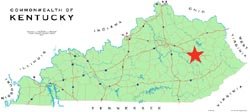
Location
Although several places could lay
claim to host the Eastern Kentucky Heritage Monument there is only
one location that would benefit and represent the entire region
equally. That location is in Wolfe County somewhere between the top
of Slade Hill and the divergence of The Bert T. Combs Mountain
Parkway and Route 15 in Campton. This is both the geographical
center of Eastern Kentucky and the "Gateway to the Mountains."
The Bert T. Combs Mountain Parkway is
the undisputed lifeline to Eastern Kentucky.
Slade Hill marks the beginning of the
Appalachian Mountains. Any point prior to this, though technically
Eastern Kentucky, is geologically associated with the "Bluegrass" or
the "Knobs."
Campton is the final point in common
to any traveler continuing into the mountains. The Mountain Parkway
carries people to Salyersville, Prestonsburg, Paintsville and
Pikeville. Route 15 carries people to Jackson, Hazard, Hindman, and
Whitesburg. A location of the Monument along either route would
exclude half of the region and thereby exacerbate our regional
problems rather than help solve them.
The Eastern Kentucky Heritage
Monument at this location provides and opens the door to all of
Eastern Kentucky. Everyone in Eastern Kentucky benefits equally. No
one is left out. Everyone wins.
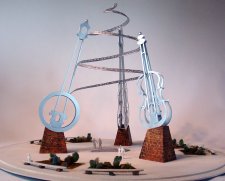
Size and Scale
The size of the monument is dependent
on the specific location. The monument must be proportional to its
environment, especially as viewed from the adjacent highway.
Monuments, by definition, are large.
The mistake of scale and proportion
as demonstrated by Louisville’s Ohio River water fountain must be
avoided. The size of the fountain, which was very large up close,
was far too small against the backdrop of the river.
The size of the instruments as
depicted in the graphic representation within this proposal is to
give the reader a general idea of the project. It is not to scale.
The actual size would depend on the location of the monument (scaled
in proportion to the surroundings), structural considerations, and
funding. Let us assume the hypothetical height of the instruments to
be fifty to seventy-five feet tall. Further research will determine
the specifications.
The instruments must be large enough
to imprint the sky when viewed from a distance but small enough to
be recognizable when viewed from the platform. Placing the
instruments on pedestals would help solve this problem. Tall
pedestals would also provide a safety deterrent to prevent people
from climbing on the instruments.
[Consultations by the artist with
professional metal fabricating companies located in Kentucky have
determined a combined height of the tallest instrument and pedestal
to be 85 feet tall. The instruments vary in height. The spiral
banding will extend a few feet higher.]
Quality, Sincerity and Excellence
A monument makes a serious statement.
It stands for something important. A monument is on a completely
different philosophical level than a park or roadside tourist
attraction. The Eastern Kentucky Heritage Monument, though friendly,
slightly whimsical and unabashedly proud, projects a feeling of
reverence and respect for the area. While our monument represents
our cultural contributions of the past, it also ambitiously
signifies our progressive expectations of the future. It must be of
the highest artistic integrity and credibility. It will be a place
of both reflection and celebration.
The Eastern Kentucky Heritage
Monument is not a place primarily designed to separate a tourist
from his or her dollar. The Monument is our gift to the visitor- a
gift proudly given.
Wind Harps
The giant guitar, banjo and fiddle of the Eastern Kentucky Heritage Monument are wind harps.
About Wind Harps
Wind Harps, also called Aeolian
Harps, are among the most ancient of mechanical instruments. From
ancient Greece we hear of a stringed box played by Aeolus, god of
the wind.
In principle, the wind harp is very
simple. A number of strings are placed over a sound chamber and the
wind causes the strings to vibrate and thereby produce a sound. The
science behind the sound is not so straightforward. Scientists have
been arguing about it since the 1650’s.
Generally, a number of strings of
various diameters are tuned to the same pitch. The air current
causes the strings to vibrate but due to the different string
diameters (and therefore tensions, since they are tuned to the same
note) the strings do not vibrate uniformly. The sound produced is
not only the expected fundamental note but also a wide series of
overtones (also called harmonics) which continually change with the
intensity of the wind.
Technically speaking, the frequency
of any Aeolian tone is equal to the product of the air stream times
a constant (normally .185, known as the Strouhal number) divided by
the string diameter. Practically speaking, the wind harp makes a lot
of really cool sounds. Descriptions of the sound range from haunting
to ethereal to delightful.
The Saint Louis Science Center,
Dallas Arboretum, The Denver Communications Building and the Port of
San Diego, among others, have small wind harp sculptures- up to
fifteen feet. The Puget Sound has one twenty-six feet tall.
The Eastern Kentucky Heritage
Monument will have the three largest wind harps in the world.

Concerning the Signatures
The signatures of noteworthy Eastern
Kentuckians are scattered across the viewing platform floor. To
preserve and honor the value of community, the hometown is also
identified. Nationally famous, regionally recognized and locally
significant people are all included. The signatures are uniformly
dispersed. There is not a specific area for the more famous. This
demonstrates that it was the collective heritage that nurtured
certain people to prominence and that they are a part of, rather
than separate from, the overall community.
The signatures are enlarged to
approximately five inches tall and twenty inches long. They are
etched into the floor and filled with colored epoxy. The different
colors represent various artistic disciplines. There would be a cost
involved in having a name inscribed. A process would be established
to determine eligibility. County governments or recognized arts
organizations would be involved in the selection process.
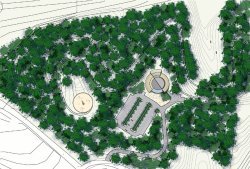
Other Nice Touches
The Monument sits on a hill above and
beyond the parking area and the Welcome, Information and
Interpretive Center. The Monument is completely free of commercial
activity.
A gentling sloping paved trail
provides an optional approach to the Monument. The trail conforms to
the Americans with Disabilities Act accessibility requirements (ADA
compliant.) However, it is not the "handicapped ramp." It is an
integral and important feature of the Monument. Indigenous plants
and trees alongside the landscaped trail are marked for
identification and educational purposes.
In the center of the viewing
platform, on the floor, is a twenty-four foot map of Kentucky.
Depicted are the rivers, geological features, cities, towns, and
points of interest. Arising from the map is a double-helix banding
that spirals upward to connect the instruments. While essentially a
structural element to provide stability, the banding will
incorporate icons representing various aspects of Appalachian life:
arrow heads, a miners hat, pick and shovel, skillet, ear of corn,
animals, etc. By touching the banding, the visitor will be
physically connected to the instruments and to the history of the
region represented by the icons.
A walking path circumnavigates the
Monument.
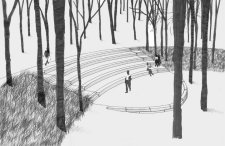
A grass amphitheater provides a
suitable location for small to medium concerts.
The Welcome, Information and
Interpretive Center provides artists from throughout Eastern
Kentucky a venue for showing their work to large numbers of people.
The work will be juried to maintain high standards. A process,
determined by the arts community, would provide equitable exhibiting
time and space to qualified artists and craftspeople.
The lighting for the Monument is slow
and stately. The multi-colored hues change over the course of long
minutes rather than seconds. There could be, however, times when a
flashy light and laser show would be appropriate. Nighttime visits
would be quite enjoyable. Sunsets on the Monument would also be very
stunning, especially for visitors from distant cities.
Concerning the Artistic Merits of the Vision
The design and vision of The Eastern
Kentucky Heritage Monument are of international artistic
significance. Artistically, our monument is unique and will warrant
world-wide comment. It is simultaneously conservative and
avant-garde. It will provide a cornucopia of intellectual stimuli
for art critics, travel writers and advertisement agencies.
The Eastern Kentucky Heritage
Monument is our international logo.
Some monuments, for example, Mt.
Rushmore, are appreciated from a distance. Some monuments, such as
the St. Louis Arch or the Washington Monument, allow two
perspectives of appreciation. One, as visual landmarks viewed from a
distance and two, as structures the visitor can enter and enjoy by
viewing the surroundings from the monument apex.
In the second type of monument, the
visitor, protected within and atop the structure, is limited to a
relatively small viewing space. They, in essence, become the "eye"
of the monument.
Our Eastern Kentucky Heritage
Monument goes further. Our visitors become the "soul" of the
monument. They are inside the instruments and walk about freely
where they will. They are "part of" the monument. Our visitors are
exposed to, and partners with, the natural elements of wind, clouds
and temperature. In addition to visual and intellectual stimuli we
have ever-changing auditory impressions determined by current wind
speed conditions.
Most monuments are essentially
static. Ours is dynamic.
Most monuments say, "Hey, look at
me." Our Monument says, "Come and personally participate in a
uniquely Eastern Kentucky experience." This is an artistic and
intellectual breakthrough in monument design and vision.
We can also boast of the "world’s
largest" in several categories: guitar, banjo, fiddle, wind harps.
Furthermore, this unique vision is
comfortable and acceptable to Appalachian sensibilities of art. It
is recognizable, non-confrontational, and elevates the emotions.
Appalachian art readily embraces the bold, the daring, and the
audacious as evidenced by our quilts and folk art. But most of all,
Appalachian art makes sense. Our Eastern Kentucky Heritage Monument,
which is far more artistically complex than it first appears, makes
perfect sense.
About the Artist
Sam McKinney is one of Eastern
Kentucky’s finest artists and most prominent sculptors. He has
graciously signed on as the lead artist for the Eastern Kentucky
Heritage Monument. Mr. McKinney’s artistic credentials and standing
in the art world are of the highest caliber.
With Mr. McKinney as lead artist, the
artistic integrity of our Monument is assured. The Art Community
cannot second-guess or question our choice.
Although good art is not "done by
committee," Sam is very interested in listening to the creative
ideas and genuine concerns of people from the area.
Sam is a native Eastern Kentuckian.
To learn more about the art of Sam
McKinney, visit his web site:
Cost Estimate
The cost of The Eastern Kentucky
Heritage Monument needs to be viewed in the context of its
contributions in making Eastern Kentucky a viable competitor in
regional, national and international tourism. The cost must be
weighed against the value of reshaping the area’s image into one
with a positive reflection of meaningful and important cultural
contributions. The question is not, therefore, how much does it cost
but what is it worth? What is it worth in terms of a positive image
of Eastern Kentucky? What is it worth in terms of tourism and the
accompanying dollars to the region? What is it worth in terms of the
pride of our people? What is it worth when the whole world knows
that Eastern Kentucky is a truly remarkable place?
Whatever it costs, it is worth
infinitely more.
Naturally, the availability of funds
would determine the scope of the project. Considering that The
Eastern Kentucky Heritage Monument will change the image of Eastern
Kentucky and that quality can not be compromised, a cost estimate of
$13 - $20 million is a reasonable figure for a project that would
meet the minimum criteria.
[This proposal was presented in 2002. At that time
the cost was estimated at $5.7 million by the local planning
committee. In 2006, professional reviews raised the cost estimate to
the numbers above. $13.5 million is generally accepted as the
working figure.]
Projected Attendance
A conservative estimate of 2.5+
million visitors per year is projected upon completion of the
Monument. This number will substantially rise as tourism increases
throughout Eastern Kentucky.
[This proposal was presented in 2002.
Professional analysis in 2004 showed the original number to be
highly optimistic. The professional visitation projection estimate
is 282,500 the first year and rising to 706,300 by the third.]
Comments, Information and Support
The Eastern Kentucky Heritage
Monument is a grassroots project. Your input is important. We
actively seek and wholeheartedly welcome your ideas, comments and
assistance.
The response to The Eastern Kentucky
Heritage Monument from people, communities and organizations
throughout the region has been overwhelmingly positive. If your club
or organization has not yet signed a letter of support, please do
so. If you would like a guest speaker to address your organization
concerning this project, please contact us.
The Eastern Kentucky Heritage
Monument is a not-for-profit 501(c)3 organization. Contributions to
the Eastern Kentucky Heritage Monument are tax deductible.
The Appalachian Heritage Alliance has
been the principal sponsor for The Eastern Kentucky Heritage
Monument Project from the beginning. We thank them for their
support. The Appalachian Heritage Alliance is a community based,
not-for-profit, 501(c)3 organization.
The Mountain Parkway Trails Corridor,
a division of Southern And Eastern Kentucky Tourism Association, has
endorsed the Monument as their priority project. We thank them for
their support.
On the web at: www.AppalachianHeritageAlliance.org
E-mail: info@AppalachianHeritageAlliance.org
phone: (606) 725-4860
Write to us at:
Eastern Kentucky Heritage Monument
PO Box 1220 Campton, KY 41301
